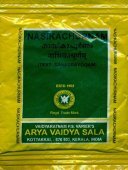Shashi, Sashi, Sasī, Śaśi, Sasi, Sāsi, Śaśī, Śaṣi, Shasi: 19 definitions
Introduction:
Shashi means something in Buddhism, Pali, Hinduism, Sanskrit, Marathi, Jainism, Prakrit, Hindi, biology, Tamil. If you want to know the exact meaning, history, etymology or English translation of this term then check out the descriptions on this page. Add your comment or reference to a book if you want to contribute to this summary article.
The Sanskrit terms Śaśi and Śaśī and Śaṣi can be transliterated into English as Sasi or Shashi, using the IAST transliteration scheme (?).
In Hinduism
Purana and Itihasa (epic history)
Source: Cologne Digital Sanskrit Dictionaries: The Purana Index1a) Śaśi (शशि).—A son of Andhaka.*
- * Matsya-purāṇa 44. 61.
1b) Moon;1 chariot of, described; relation of, to the sun cosmology; his nectar and its use to gods, ṛṣis and pitṛs;2 his maṇḍala twice that of the sun;3 vanquished by Rāvaṇa.4
- 1) Matsya-purāṇa 93. 13.
- 2) Ib. 126. 48-73.
- 3) Ib. 124. 8.
- 4) Brahmāṇḍa-purāṇa II. 21. 8; 24. 67; III. 7. 254.

The Purana (पुराण, purāṇas) refers to Sanskrit literature preserving ancient India’s vast cultural history, including historical legends, religious ceremonies, various arts and sciences. The eighteen mahapuranas total over 400,000 shlokas (metrical couplets) and date to at least several centuries BCE.
Vastushastra (architecture)
Source: Wisdom Library: Vāstu-śāstraŚaśi (शशि, “monday”) corresponds with the moon and refers to the second of seven vāra (days), according to the Mānasāra. It is also known by the name Soma or Candra. Vāra is the fifth of the āyādiṣaḍvarga, or “six principles” that constitute the “horoscope” of an architectural or iconographic object. Their application is intended to “verify” the measurements of the architectural and iconographic object against the dictates of astrology that lay out the conditions of auspiciousness.
The particular day, or vāra (e.g., śaśi) of all architectural and iconographic objects (settlement, building, image) must be calculated and ascertained. This process is based on the principle of the remainder. An arithmetical formula to be used in each case is stipulated, which engages one of the basic dimensions of the object (breadth, length, or perimeter/circumference). Among these vāras, Guru (Thursday), Śukra (Friday), Budha (Wednesday) and Śaśi or Candra (Monday), are considered auspicious and therefore, to be preferred. The text states, however, that the inauspiciousness of the other three days are nullified if there occurs a śubhayoga, “auspicious conjunction (of planets)” on those days.

Vastushastra (वास्तुशास्त्र, vāstuśāstra) refers to the ancient Indian science (shastra) of architecture (vastu), dealing with topics such architecture, sculpture, town-building, fort building and various other constructions. Vastu also deals with the philosophy of the architectural relation with the cosmic universe.
Chandas (prosody, study of Sanskrit metres)
Source: Shodhganga: a concise history of Sanskrit Chanda literatureŚaśī (शशी) refers to one of the 130 varṇavṛttas (syllabo-quantitative verse) dealt with in the second chapter of the Vṛttamuktāvalī, ascribed to Durgādatta (19th century), author of eight Sanskrit work and patronised by Hindupati: an ancient king of the Bundela tribe (presently Bundelkhand of Uttar Pradesh). A Varṇavṛtta (e.g., śaśī) refers to a type of classical Sanskrit metre depending on syllable count where the light-heavy patterns are fixed.

Chandas (छन्दस्) refers to Sanskrit prosody and represents one of the six Vedangas (auxiliary disciplines belonging to the study of the Vedas). The science of prosody (chandas-shastra) focusses on the study of the poetic meters such as the commonly known twenty-six metres mentioned by Pingalas.
Jyotisha (astronomy and astrology)
Source: Wikibooks (hi): Sanskrit Technical TermsŚaṣi (शषि).—The Moon. Note: Śaṣi is a Sanskrit technical term used in ancient Indian sciences such as Astronomy, Mathematics and Geometry.

Jyotisha (ज्योतिष, jyotiṣa or jyotish) refers to ‘astronomy’ or “Vedic astrology” and represents the fifth of the six Vedangas (additional sciences to be studied along with the Vedas). Jyotisha concerns itself with the study and prediction of the movements of celestial bodies, in order to calculate the auspicious time for rituals and ceremonies.
Shaivism (Shaiva philosophy)
Source: Shodhganga: Iconographical representations of ŚivaŚaśi (शशि) is the name of a deity who received the Suprabhedāgama from Vighneśa who in turn, received it from Daśeśa through the mahānsambandha relation, according to the pratisaṃhitā theory of Āgama origin and relationship (sambandha). The suprabheda-āgama, being part of the ten Śivabhedāgamas, refers to one of the twenty-eight Siddhāntāgamas: a classification of the Śaiva division of Śaivāgamas. The Śaivāgamas represent the wisdom that has come down from lord Śiva, received by Pārvatī and accepted by Viṣṇu.
Śaśi obtained the Suprabhedāgama from Vighneśa who in turn obtained it from Daśeśa who in turn obtained it from Sadāśiva through parasambandha. Śaśi then, through divya-sambandha transmitted it to the Devas who, through divyādivya-sambandha, transmitted it to the Ṛṣis who finally, through adivya-sambandha, revealed the Suprabhedāgama to human beings (Manuṣya). (also see Anantaśambhu’s commentary on the Siddhāntasārāvali of Trilocanaśivācārya)

Shaiva (शैव, śaiva) or Shaivism (śaivism) represents a tradition of Hinduism worshiping Shiva as the supreme being. Closely related to Shaktism, Shaiva literature includes a range of scriptures, including Tantras, while the root of this tradition may be traced back to the ancient Vedas.
Ganitashastra (Mathematics and Algebra)
Source: archive.org: Hindu MathematicsŚaśi (शशि) represents the number 1 (one) in the “word-numeral system” (bhūtasaṃkhyā), which was used in Sanskrit texts dealing with astronomy, mathematics, metrics, as well as in the dates of inscriptions and manuscripts in ancient Indian literature.—A system of expressing numbers by means of words arranged as in the place-value notation was developed and perfected in India in the early centuries of the Christian era. In this system the numerals [e.g., 1—śaśi] are expressed by names of things, beings or concepts, which, naturally or in accordance with the teaching of the Śāstras, connote numbers.

Ganitashastra (शिल्पशास्त्र, gaṇitaśāstra) refers to the ancient Indian science of mathematics, algebra, number theory, arithmetic, etc. Closely allied with astronomy, both were commonly taught and studied in universities, even since the 1st millennium BCE. Ganita-shastra also includes ritualistic math-books such as the Shulba-sutras.
In Buddhism
Tibetan Buddhism (Vajrayana or tantric Buddhism)
Source: academia.edu: The Structure and Meanings of the Heruka MaṇḍalaŚaśī (शशी) is the name of a Ḍākinī who, together with the Vīra (hero) named Śaśa forms one of the 36 pairs situated in the Medinīcakra, according to the 10th century Ḍākārṇava chapter 15. Accordingly, the medinīcakra refers to one of the three divisions of the dharma-puṭa (‘dharma layer’), situated in the Herukamaṇḍala. The 36 pairs of Ḍākinīs [viz., Śaśī] and Vīras are yellow in color; the shapes of their faces are in accordance with their names; they have four arms; they hold a skull bowl, a skull staff, a small drum, and a knife.

Tibetan Buddhism includes schools such as Nyingma, Kadampa, Kagyu and Gelug. Their primary canon of literature is divided in two broad categories: The Kangyur, which consists of Buddha’s words, and the Tengyur, which includes commentaries from various sources. Esotericism and tantra techniques (vajrayāna) are collected indepently.
Biology (plants and animals)
Source: Google Books: CRC World Dictionary (Regional names)1) Sasi in India is the name of a plant defined with Cinnamomum camphora in various botanical sources. This page contains potential references in Ayurveda, modern medicine, and other folk traditions or local practices It has the synonym Cinnamomum camphora (L.) Nees & Eberm., nom. illeg. (among others).
2) Sasi in Sierra Leone is also identified with Maranthes glabra It has the synonym Parinari glabra Oliv. (etc.).
Example references for further research on medicinal uses or toxicity (see latin names for full list):
· Flora of Tropical Africa (1871)
· Systema Vegetabilium (1825)
· Journal of Wuhan Botanical Research (1998)
· Species Plantarum (1753)
· Boletim da Sociedade Broteriana (1966)
· Verhandelingen van het Bataviaasch Genootschap van Kunsten en Wetenschappen (1830)
If you are looking for specific details regarding Sasi, for example side effects, health benefits, chemical composition, pregnancy safety, extract dosage, diet and recipes, have a look at these references.

This sections includes definitions from the five kingdoms of living things: Animals, Plants, Fungi, Protists and Monera. It will include both the official binomial nomenclature (scientific names usually in Latin) as well as regional spellings and variants.
Languages of India and abroad
Pali-English dictionary
Source: BuddhaSasana: Concise Pali-English Dictionarysasī : (m.) the moon. || sāsi (aor. of sāsati), taught; instructed; ruled.

Pali is the language of the Tipiṭaka, which is the sacred canon of Theravāda Buddhism and contains much of the Buddha’s speech. Closeley related to Sanskrit, both languages are used interchangeably between religions.
Marathi-English dictionary
Source: DDSA: The Aryabhusan school dictionary, Marathi-Englishśaśi (शशि).—m The moon.
Marathi is an Indo-European language having over 70 million native speakers people in (predominantly) Maharashtra India. Marathi, like many other Indo-Aryan languages, evolved from early forms of Prakrit, which itself is a subset of Sanskrit, one of the most ancient languages of the world.
Sanskrit dictionary
Source: DDSA: The practical Sanskrit-English dictionarySāsi (सासि).—a. Armed with a sword; also सासिपाण-हस्त (sāsipāṇa-hasta).
Source: Cologne Digital Sanskrit Dictionaries: Edgerton Buddhist Hybrid Sanskrit DictionaryŚaśī (शशी).—name of an apsaras: Kāraṇḍavvūha 3.18.
Source: Cologne Digital Sanskrit Dictionaries: Shabda-Sagara Sanskrit-English DictionaryŚasi (शसि) or Śas.—and the preposition āṅ usually prefixed āśasi r. 1st cl. (āśaṃsate) 1. To bless, to wish good to, to confer a benediction. 2. To wish, to desire. 3. To speak. (u) śasu r. 1st cl. (śasati) To hurt, to injure, to wound or kill. With abhi, To intreat. With vi, To kill. r. 2nd cl. śasti To dream.
Source: Cologne Digital Sanskrit Dictionaries: Cappeller Sanskrit-English DictionarySaśī (सशी).—be undecided or in doubt, despair of ([locative]); A. disagree about ([accusative]). — Cf. atiśayita, saṃśayita.
Saśī is a Sanskrit compound consisting of the terms sa and śī (शी).
Source: Cologne Digital Sanskrit Dictionaries: Monier-Williams Sanskrit-English Dictionary1) Śaśī (शशी):—[from śaśa > śaś] a f. Name of an Apsaras, [Kāraṇḍa-vyūha]
2) Śaśi (शशि):—[from śaś] in [compound] for śaśin.
3) Śaśī (शशी):—[from śaś] 1. śaśī f. See under śaśa.
4) [v.s. ...] 2. śaśī in [compound] for śaśa.
5) Sāsi (सासि):—mfn. having a sword, armed with a sword, [Monier-Williams’ Sanskrit-English Dictionary]
Sanskrit, also spelled संस्कृतम् (saṃskṛtam), is an ancient language of India commonly seen as the grandmother of the Indo-European language family (even English!). Closely allied with Prakrit and Pali, Sanskrit is more exhaustive in both grammar and terms and has the most extensive collection of literature in the world, greatly surpassing its sister-languages Greek and Latin.
Hindi dictionary
Source: DDSA: A practical Hindi-English dictionary1) Śaśi (शशि):—(nm) the moon; -[kalā] a digit of the moon; ~[maṃḍala] the disc of the moon; ~[mukha] having a moon-like/pretty face, beautiful; hence ~[mukhī] (a).
2) Śāsī (शासी):—(a) governing; ~[maṃḍala] governing body.
3) Sasi (ससि):—(nm) the moon.
...
Prakrit-English dictionary
Source: DDSA: Paia-sadda-mahannavo; a comprehensive Prakrit Hindi dictionary1) Sasi (ससि) in the Prakrit language is related to the Sanskrit word: Śaśin.
2) Sāsi (सासि) also relates to the Sanskrit word: Śvāsin.
Prakrit is an ancient language closely associated with both Pali and Sanskrit. Jain literature is often composed in this language or sub-dialects, such as the Agamas and their commentaries which are written in Ardhamagadhi and Maharashtri Prakrit. The earliest extant texts can be dated to as early as the 4th century BCE although core portions might be older.
Kannada-English dictionary
Source: Alar: Kannada-English corpusŚaśi (ಶಶಿ):—
1) [noun] the moon (whose black spots are presumed to resemble a hare).
2) [noun] a whitish, translucent, crystalline, pleasant-odoured terpene ketone, obtained from the camphor tree, used chiefly in the manufacture of celluloid and in medicine as a counter-irritant for infections and in the treatment of pain and itching; camphor.
3) [noun] (pros.) a metrical foot consisting of one long syllablic instant followed by two short ones (-uu); dactylus.
4) [noun] (math.) a symbol for the number one.
--- OR ---
Sasi (ಸಸಿ):—
1) [verb] to pull out by the roots; to root up.
2) [verb] to cut, sever (a part from the whole).
3) [verb] to comb and clean cotton.
4) [verb] to fall down (as a fruit from the plant or a tooth from the jaw).
5) [verb] (a group of persons, animal or a heap of things) to break up and move in different directions; to scatter; to disperse.
6) [verb] to squeeze or compress tightly between the thumb, and a finger (to inflict pain); to nip; to pinch.
--- OR ---
Sasi (ಸಸಿ):—
1) [noun] the moon (whose black spots are presumed to resemble a hare).
2) [noun] a whitish, translucent, crystalline, pleasant-odoured terpene ketone, obtained from the camphor tree, used chiefly in the manufacture of celluloid and in medicine as a counter-irritant for infections and in the treatment of pain and itching; camphor.
--- OR ---
Sasi (ಸಸಿ):—
1) [noun] a young plant.
2) [noun] (fig.) a beginning, start (of something).
--- OR ---
Sāsi (ಸಾಸಿ):—[noun] = ಸಾಸಿಗ [sasiga]2 - 1 & 2.
Kannada is a Dravidian language (as opposed to the Indo-European language family) mainly spoken in the southwestern region of India.
Tamil dictionary
Source: DDSA: University of Madras: Tamil LexiconŚaśi (ஶஶி) [śāśi] noun < Śaśī nominative singular of śaśin. Moon. See சசி¹ [sasi¹], 1.
Tamil is an ancient language of India from the Dravidian family spoken by roughly 250 million people mainly in southern India and Sri Lanka.
See also (Relevant definitions)
Partial matches: Shi, Sha, Ci, Ca.
Starts with (+84): Sashirajan, Sasin, Sasisa, Sasita, Shashib, Shashibha, Shashibhaparvan, Shashibhas, Shashibhrit, Shashibhu, Shashibhushana, Shashibimba, Shashibindu, Shashicuda, Shashidaiva, Shashideva, Shashidevavritti, Shashidhaman, Shashidhara, Shashidharamangalamata.
Ends with: Amishashi, Ardhashashi, Arkashashin, Ashashi, Balashashi, Khamdashashi, Kishorashashi, Rakshasi, Ravishashin, Shakabhikshashin, Yavakabhikshashin.
Full-text (+161): Shashishekhara, Shashilekha, Shashivadana, Shashipada, Shashiprabha, Sasihasta, Shasi mulu, Sasipani, Sasalanchana, Shashadhara, Shashibhu, Shashalakshma, Sasi gach, Shashimukhi, Shashivamshaja, Shashidharamangalamata, Shashikanta, Shashibhrit, Shashikhandapada, Shashimukha.
Relevant text
Search found 51 books and stories containing Shashi, Sa-shi, Sa-śī, Sa-si, Sashi, Sasī, Śaśi, Sasi, Sāsi, Śaśī, Śaṣi, Śasi, Saśī, Śāsī, Shasi; (plurals include: Shashis, shis, śīs, sis, Sashis, Sasīs, Śaśis, Sasis, Sāsis, Śaśīs, Śaṣis, Śasis, Saśīs, Śāsīs, Shasis). You can also click to the full overview containing English textual excerpts. Below are direct links for the most relevant articles:
Emergence of the New Indian Women: Shashi < [April – June, 2006]
Who’s Who < [April – June, 2007]
Book Reviews < [July – September, 1993]
Shat-cakra-nirupana (the six bodily centres) (by Arthur Avalon)
Historical Elements in the Matsya Purana (by Chaitali Kadia)
Lineages of Kaśyapa < [Chapter 6 - Human history in the Matsya-Purāṇa]
Dynasty of Kroṣṭu < [Chapter 6 - Human history in the Matsya-Purāṇa]
Garga Samhita (English) (by Danavir Goswami)
Verse 8.13.78 < [Chapter 13 - A Thousand Names of Lord Balarāma]
Shrimad Bhagavad-gita (by Narayana Gosvami)
Verse 10.21 < [Chapter 10 - Vibhūti-yoga (appreciating the opulences of the Supreme Lord)]
Verse 11.19 < [Chapter 11 - Viśvarūpa-darśana-yoga (beholding the Lord’s Universal Form)]
Verse 7.8 < [Chapter 7 - Vijñāna-Yoga (Yoga through Realization of Transcendental Knowledge)]
Sahitya-kaumudi by Baladeva Vidyabhushana (by Gaurapada Dāsa)
Text 7.19 < [Chapter 7 - Literary Faults]
Text 7.128 < [Chapter 7 - Literary Faults]
Text 11.5 < [Chapter 11 - Additional Ornaments]
Related products



